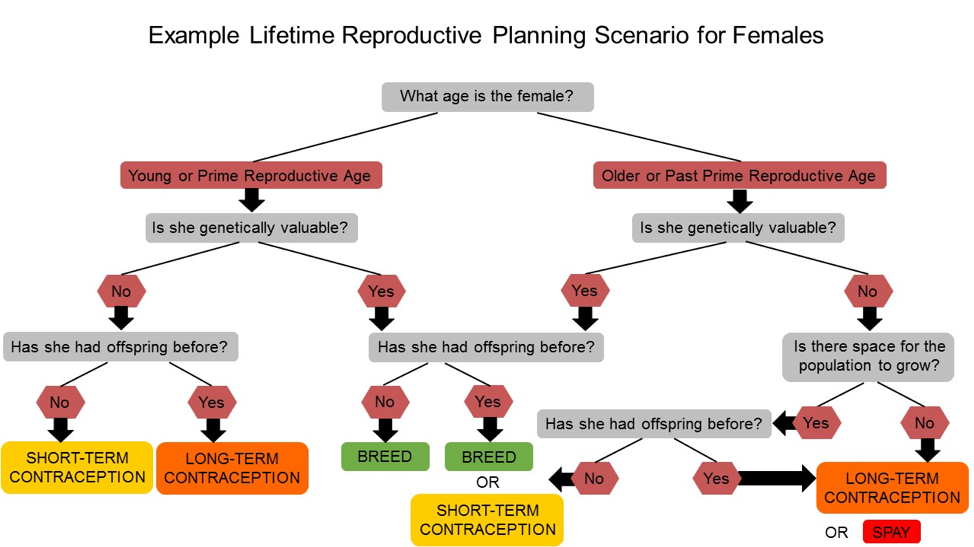
Reproductive Enhancement

Many managed captive animal populations experience low rates of reproductive success. Reasons for reproductive failure may include, for example, pair incompatibility, improper light cycles, insufficient flock size, inadequate nutrition or over-conditioning, and physiological infertility as well as logistical considerations. The RMC’s role is to identify patterns of reproductive failure across a population or across taxonomic groups and to develop tools that can be used to increase reproductive success rates. In contrast, the Reproduction and Endocrine Scientific Advisory Group addresses more specific problems, such as assisting institutions in evaluating reproductive failure in individual animals or pairs.
Initiatives
RMC initiatives related to evaluating large-scale threats to captive population sustainability have included:
- Partnering with the Reproductive Health Surveillance Program for research on the relationship between reproductive pathology and infertility
- Workshops and demonstration videos
- Ongoing research projects related to contraception reversibility.
- Reproductive Viability Analysis (RVA) to assess the biological and pair-related factors important for increasing reproductive success in a species.
- Lifetime Reproductive Planning designed to establish and maintain female fertility
- Developing tools, such as the Reproductive Checklist to Assess Fertility, that can be used by the AZA zoo community to evaluate fertility in males and female
Contacts and Tools
AZA Scientific Advisory Groups and Committees: The RMC integrates and coordinates with the AZA SAGs and Committees that are most relevant to addressing the causes of reproductive failure.
Reproduction Advisors: Many TAGs and SSPs have Reproduction Advisors who can provide expert advice on topics related to reproduction. The Reproduction and Endocrine SAG can assist you with identifying the appropriate Reproduction Advisor for your species.
Transcervical Endometrial Biopsy: This tool, developed by our colleague, Dr. Bruce Christensen, can be useful in detecting early-stage pathological changes in the uterine endometrium. Transcervical endometrial biopsy offers the possibility of diagnosing uterine pathologies before they advance, so that therapies can be implemented sooner. Dr. Christensen has trained a network of veterinarians across the U.S. to perform the biopsies and the RMC can coordinate the procedure for your institution. To date, biopsies have been performed in large canids and felids (African painted dogs, African lions, red and Mexican wolves). Please contact us for more information, contraception@stlzoo.org.
Reproductive Checklist to Assess Fertility: In 2021, the RMC worked with the European Association of Zoo & Aquaria’s Reproductive Management Group (EAZA RMG) and the Reproduction & Endocrinology Scientific Advisory Group (RESAG) to create a more standardized and comprehensive Reproductive Checklist to Assess Fertility. This exhaustive checklist is intended to foster dialog between keepers, curators, veterinarians, and consulting reproductive specialists when trying to diagnose fertility-related issues.
Reproductive Viability Analyses (RVA)
The RMC has worked with the following Species Survival Plan® (SSP) Programs on RVA:
- Fennec fox (Vulpes zerda); Bauman et al. 2019
- Mexican wolf (Canis lupus baileyi); Bauman et al. 2019
- Asian small-clawed otter (Aonyx cinereus)
- Red River Hog (Potamochoerus porcus)
- American red wolf (Canis rufus)
Are you interested in an RVA for your SSP? Please contact us for more information.
Lifetime Reproductive Planning
In light of the need to ensure the sustainability of ex situ animal populations, the RMC is developing alternative approaches to reproductive management. Lifetime Reproductive Planning (LRP) recognizes that fertility is best established and maintained by allowing reproduction not long after puberty and then at regular intervals throughout a female’s life, until her genetic contribution to the population is reached. However, early and regular reproduction must be balanced with effects on the gene diversity of the population, its age structure, and the current holding capacity for the species in zoos. We are currently developing models to test the effects of various potential reproductive management scenarios on population genetics, long-term population sustainability, and population size. Running these models will allow us to see how using a certain strategy will affect the population before we actually implement the strategy for reproductive management.
Ideally, animal breeding programs would breed every female after puberty in order to establish her fertility. Then, depending on her genetic value, she would follow one of many possible trajectories, either spacing out subsequent pregnancies using contraceptives, breeding her several times before putting her on long-term contraception (or spaying her), or she may be put on long term contraception at a younger age if her genetic line is overrepresented in the population. Unfortunately, in most populations, breeding all females at puberty will likely have significant negative genetic and demographic consequences; therefore, the reproductive strategies that we are investigating include delaying the age of first reproduction in some females and excluding some females from the breeding population entirely.
Though the original concept for LRP was to predetermine a female’s reproductive future based on her genetic value at puberty, LRP will more realistically look like more of a decision tree that determines a female’s reproductive status based on several factors at the time of population planning. In addition to her genetic value, other factors such as her age, prior parity, and how close the population is to its target population size should be considered. This may be particularly important in populations where a female’s position on the mean kinship list changes significantly between breeding and transfer planning periods. Using this approach also allows us to incorporate more flexibility in the reproductive management strategy based on how the population is performing. See the schematic below for a conceptual look at LRP.


